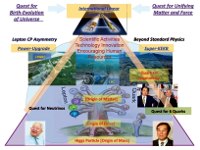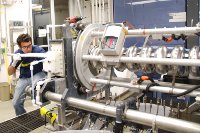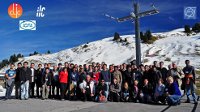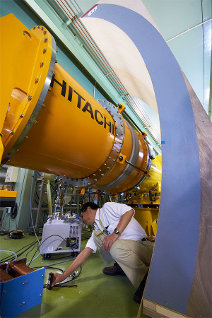 |
|
|
 |
ILC and Super KEKB
This month's Research Director's Report was written by Hitoshi Yamamoto, co-chair of the World Wide Study and regional detector contact for Asia.

KEK roadmap. Image: KEK. |
In 2008, KEK formulated the so-called KEK roadmap that defined priorities for the Japanese high-energy physics programme for the following five years. This was a result of intense discussions within the Japanese high-energy physics community and was also reviewed and endorsed by an international review panel. It placed the ILC at the top of a pyramid, with a second tier containing J-PARC, the LHC, and Super KEKB, an upgrade of KEKB to achieve 40 times higher luminosity with a three-year shutdown. Around that time, there was already significant Japanese participation in the LHC at CERN, and J-PARC was moving from its construction phase to the operation phase. Super KEKB, however, had an uncertain future, and the highest priority of KEK was to secure funding for Super KEKB. Then in June 2010, MEXT (the Japanese ministry of education, culture, sports, science and technology) appropriated 100 oku-yen (~120 million dollars) to the KEKB upgrade from a special fund called the 'very advanced research support programme'. Even though additional funds are needed to complete the Super KEKB upgrade, this signaled an essential go-ahead for the project, clearing the way for the ILC.
Read more...
-- Hitoshi Yamamoto
Research Director's Report Archive |
 |
|
|
 |
|
 |
Jefferson Lab's rules for achieving spotless cavities

Jefferson Lab technician James Davenport carefully inserts a cathode into an ILC nine-cell cavity for the electropolishing process. Successful placement of the cathode requires a steady hand since the cavity aperture is very small. Image: Rongli Geng |
Depending on your household's rules of cleaning, you may have learned about a "right way" to wash dishes: keep dishwater clean for as long as you can, cleaning glasses first, then silverware, then plates. Save the dirtiest wares, pots and pans, for last.
A research team at Jefferson Lab has developed its own detailed set of rules for optimal cleaning. Team members have been working on a regimen for removing imperfections and impurities from superconducting radiofrequency (SRF) niobium cavities. Their procedures, they believe, have helped create cavities that could exceed ILC 2010 performance benchmarks.
Read more...
-- Leah Hesla |
 |
|
|
 |
From CERN Bulletin
15 November 2010
"See you soon" – a retrospective on the first LHC proton run
In a series of interviews, the spokespersons from the five experiments take stock of the unprecedented success of the proton run.
Read more... |
|
From The Beacon News
13 November 2010
Fermilab offers buyouts, hopes to cut 50 workers
The reason, Oddone said, is the ongoing question of the 2011 federal budget, and how Fermilab ó and science in general ó will fit in.
Read more... |
|
From Discovery Magazine
13 November 2010
Mapping the Dark Matter
This isnít all about the pretty pictures. We have theoretical predictions about how dark matter should act, and itís good to compare them to data
Read more... |
|
From Physics World
11 November 2010
LHC sees its first ZZ event
Seeing this first pair is an important step in the giant collider's hunt for the Higgs boson because the generation and analysis of many more such events could provide one of the key signatures of the elusive Higgs.
Read more... |
|
From KEK
15 October 2010
Japanese ILC Newsletter
Read in Japanese
Read more... |
|
|
 |
 |
|
|
 |
Linear Collider Accelerator School

International Linear Collider School 2010 group photo |
Following the very intense joint ILC/CLIC workshop (IWLC10) in Geneva last month, I went around Lake Geneva to Villars-sur-Ollon. Our fifth Linear Collider Accelerator School, and the first one sponsored jointly by ILC and CLIC, was held there from 25 October to 5 November 2010. This was a beautiful and comfortable setting for the school, conducive to academic teaching, situated in the mountains and fostering social interactions. In my opinion, one of the most important outcomes of the ILC Global Design Effort is the role we play in the training of future generations of accelerator scientists. The lecturers at the school are leaders of the field, the topics covered are both academically interesting and involve todayís forefront research issues, the organization by Alex Chao and Weiren Chou is superb, and the combination of all these aspects has made this a very special yearly event.
Read more...
-- Barry Barish
Director's Corner Archive |
 |
|
|
 |
Wooden mock-up tunnel

Two sets of wooden mock-ups were built so as to present part of the inner surfaces of the ILC tunnel (inner diameter tentatively set to be 5.7m). They have been placed in the underground accelerator housing of the Superconducting Test Facility at KEK. Image: Nobu Toge.
|
arXiv preprints
1011.2449
Testing the CP-violating MSSM in stau decays at the LHC and ILC
|
|

